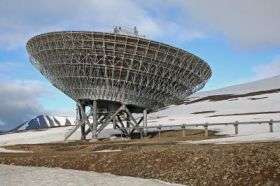First advert to be broadcast into space

The campaign to broadcast the first ever advert into space is launched today (Friday March 7)- with University of Leicester space scientists playing a key part in the process.
The British public is being asked to shoot a 30-second ad about what they perceive life on earth to be as part of Doritos ‘You Make It, We Play It’ user-generated-content campaign. The winning advert in the competition will be beamed past the earth's atmosphere, beyond our solar system and into the Universe, to anyone 'out there' that may be watching. The winning ad will also be broadcast on terrestrial TV.
On 12th June, the space-bound ad will be broadcast from a 500MHz Ultra High Frequency Radar from the EISCAT Space Centre in Svalbard, which lies in the Arctic Ocean about midway between northern Norway and the North Pole.
The transmission is being directed at a solar system just 42 light years away from Earth with planets that orbit its star '47 Ursae Majoris' (UMa). 47 UMa is located in the Great Bear Constellation (also known as “The Plough”) - easily identifiable to even the most amateur stargazer. It is very similar to our Sun and is believed to host a habitable zone that could potentially harbour small terrestrial planets and support life as we know it.
The advert will travel at the speed of light and continue for an indefinite period. Within 1.2 seconds the transmission will pass our moon, after 4.5 minutes it will pass Mars (77million kilometres away), in under 9 minutes the signal will whiz past the Sun and five and a half hours later it will travel past Pluto and out of our solar system.
The effective power of the transmitted signal to the Universe will be around two thousand million watts (a normal light bulb is 100 watts), ensuring the advert could be received and watched hundreds of light years from Earth.
The advert will be coded in '1's and '0's (as used for most computer communications) represented by phase changes of the transmitted signal. The message will be broken into sections and each of the pulses will be numbered so that any intelligent life on recipient planets can mathematically reassemble them. This allows scientists to send a signal that is both powerful and easy to recover, even when weakened by the great distance to its planned destination.
The competition is being run by Doritos, as part of its new 'You Make It, We Play It' initiative. The project is being undertaken in association with experts and academics from the University of Leicester and is also being supported by EISCAT (The European Incoherent SCATter Scientific Association), which studies solar-planetary interactions and operate a series of radar systems, including the Svalbard transmitter.
Professor Tony van Eyken, Director of EISCAT, said: "Broadcasting an advert extra-terrestrially is a big and exciting step for everyone on Earth as up until now we only tend to listen for incoming transmissions. There have been reports that NASA beamed a Beatles song towards the Polaris star system, though as this is a 1,000 light year round trip, it's highly unlikely it will ever be received by extra-terrestrials. With the transmission technology and planning we are employing there is a much greater chance that the Doritos advert will potentially be seen by any alien life form.
“The UK is launching back into the space race with plans for billions of pounds to be invested in space exploration. A member of the British public communicating with the Universe is a natural extension of the democratization of space in the 21st Century."
Dr Darren Wright of the University of Leicester Department of Physics and Astronomy said: “The Radio and Space Plasma Physics Group and Department of Physics and Astronomy as a whole at the University of Leicester has a very high international profile in the area of Space Physics.
“An important part of this project is that it provides an additional component to the Physics and Astronomy Department’s ever increasing outreach programme. The ad to be transmitted will be created by the public following a national competition thus increasing public awareness of space activities.
“The launch of this project as we embark on National Science and Engineering Week- with a range of activities taking place at the University of Leicester- is timely, and adds impetus to our efforts to interest people in science.
Source: University of Leicester





















